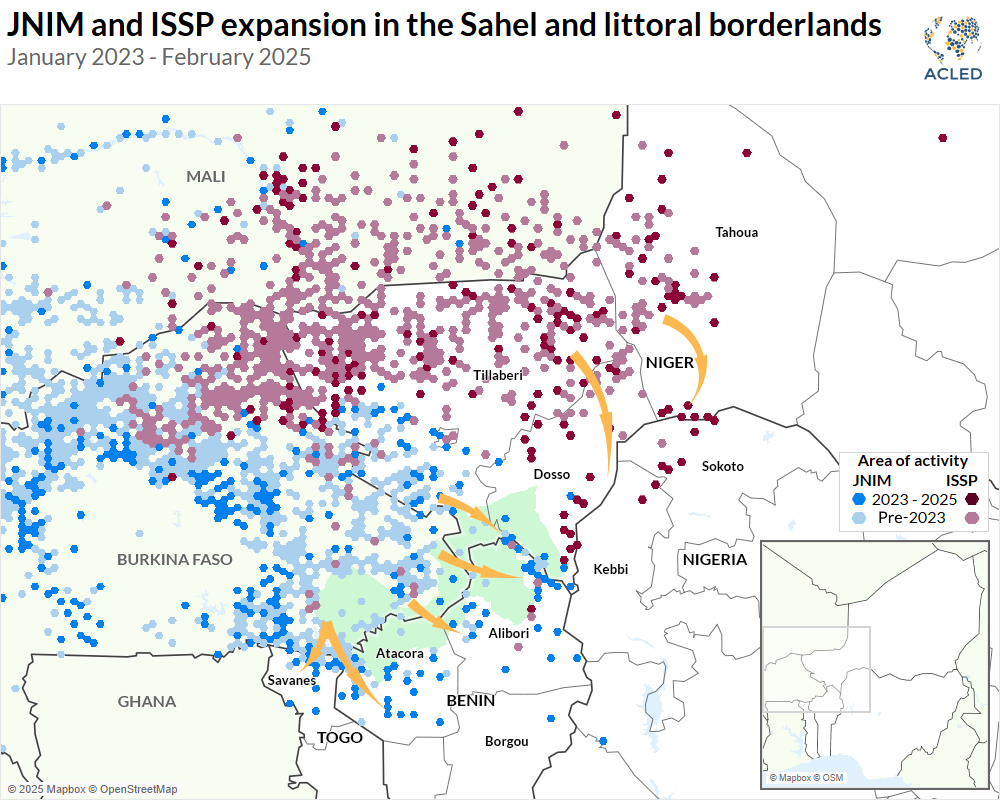Benin, Niger, Nigeria: New Jihadist Frontlines Emerge
Editor's Note: The escalating jihadist threat across Benin, Niger, and Nigeria has sparked urgent concerns. This article analyzes the emerging frontlines and their implications.
1. Why This Matters:
The Sahel region is facing a rapidly evolving jihadist crisis. The expansion of extremist groups into Benin, previously considered relatively stable, signals a significant shift in the conflict’s geography and intensity. Understanding this new front is crucial for regional stability and international counter-terrorism efforts. This article explores the key actors, motivations, and the potential consequences of this escalating threat. Key areas examined include the spillover effects from Burkina Faso and Mali, the vulnerabilities within each nation's security apparatus, and the humanitarian crisis unfolding in the affected regions.
2. Key Takeaways:
| Point | Detail |
|---|---|
| Geographic Expansion | Jihadist groups are no longer confined to traditional strongholds. |
| Increased Violence | Attacks in Benin, Niger, and Nigeria are increasing in frequency and brutality. |
| Weak State Capacity | Limited resources and capacity hinder effective counter-terrorism responses. |
| Humanitarian Crisis | Civilians are suffering displacement, food insecurity, and widespread violence. |
| Regional Instability | The crisis threatens to destabilize the entire Sahel region. |
3. Main Content
3.1 Benin, Niger, Nigeria: A New Jihadist Front
Introduction: The relatively peaceful landscapes of Benin are increasingly becoming battlegrounds for armed jihadist groups. This expansion, fueled by instability in neighboring Burkina Faso and Mali, poses a significant threat to regional security and stability.
Key Aspects: The porous borders between Benin, Niger, and Nigeria allow for easy movement of fighters, weapons, and resources. The weak governance and limited resources in these areas exacerbate the problem. Local grievances and ethnic tensions are exploited by jihadist groups to recruit and gain support.
Detailed Analysis: Groups like ISIS-Greater Sahara (ISGS) and Jama'at Nusrat al-Islam wal-Muslimin (JNIM) are increasingly active in the region, carrying out attacks targeting both military personnel and civilians. These groups exploit the lack of state presence and the poverty within communities to gain traction. The increasing frequency of attacks in the Liptako-Gourma region, spanning parts of these three countries, demonstrates their growing capacity and ambition.
3.2 Interactive Elements on the Jihadist Threat
Introduction: The conflict is not a static situation; it's dynamic and influenced by numerous interactive factors.
Facets: The flow of fighters across borders, the competition between different jihadist groups, the response of regional and international actors, and the resilience of local communities all play significant roles in shaping the conflict. Climate change and desertification further exacerbate the situation by increasing competition for resources and exacerbating existing tensions.
Summary: These interactive elements highlight the complexity of the problem, necessitating a multi-faceted approach to address it. Simply focusing on military action will not be sufficient. Addressing the root causes, including poverty, inequality, and weak governance, is critical for long-term stability.
3.3 Advanced Insights on the Jihadist Threat
Introduction: A deeper understanding of the socio-political dynamics is essential to formulating effective strategies.
Further Analysis: Expert opinions highlight the need for collaborative efforts between governments, civil society organizations, and international partners. This includes strengthening governance structures, promoting economic development, and addressing underlying social grievances. The role of misinformation and propaganda in recruiting and mobilizing fighters is also crucial to understand.
Closing: The long-term success of counter-terrorism efforts in the region depends on a comprehensive and holistic approach that addresses the security, political, economic, and social dimensions of the crisis.
4. People Also Ask (NLP-Friendly Answers)
Q1: What is the Jihadist threat in Benin, Niger, and Nigeria? A: It's the growing presence and activity of extremist groups like ISGS and JNIM, carrying out attacks and destabilizing the region.
Q2: Why is this threat important? A: It threatens regional stability, displaces civilians, creates a humanitarian crisis, and undermines development efforts.
Q3: How can this threat affect me? A: The crisis can indirectly impact global security through the potential for international terrorism and humanitarian consequences requiring global assistance.
Q4: What are the main challenges in addressing this threat? A: Porous borders, weak governance, limited resources, and the complexity of the underlying socio-political factors.
Q5: How to help? A: Support organizations working on humanitarian relief, advocate for stronger international engagement, and promote policies that address the root causes of the conflict.
5. Practical Tips for Understanding the Crisis:
Introduction: Understanding this complex situation requires accessing reliable information.
Tips:
- Follow reputable news sources for updates.
- Research the history and context of the conflict.
- Support organizations providing humanitarian aid.
- Advocate for responsible governance and security reforms.
- Engage in respectful discussions about the issue.
- Educate yourself on the complexities of the crisis.
- Support initiatives that promote peacebuilding and development in the region.
- Be mindful of misinformation and biased narratives.
Summary: By staying informed and engaged, you can contribute to a better understanding and response to this urgent crisis.
Transition: The situation in the Sahel demands urgent attention and collective action.
6. Summary:
The emergence of new jihadist frontlines in Benin, Niger, and Nigeria represents a significant escalation of the conflict in the Sahel. Addressing this complex challenge requires a comprehensive approach that combines security measures with efforts to address the underlying socio-political and economic factors driving the conflict. International cooperation and a sustained commitment to long-term solutions are crucial to restoring stability and preventing further suffering in the region.
7. Call to Action:
Ready to learn more? Subscribe to our newsletter for in-depth analysis of the evolving situation in the Sahel.

